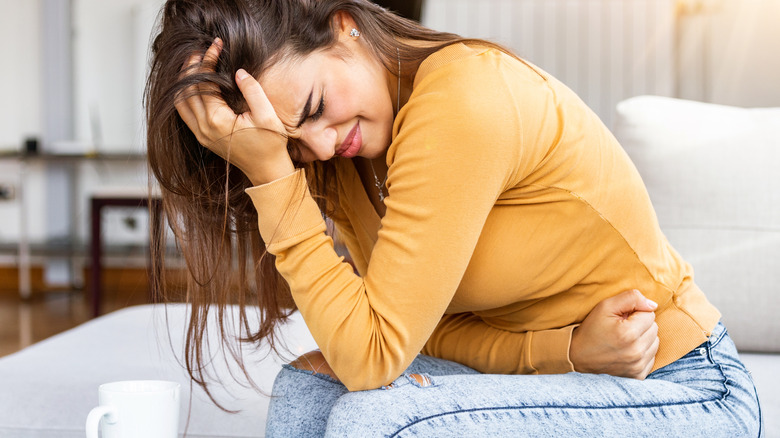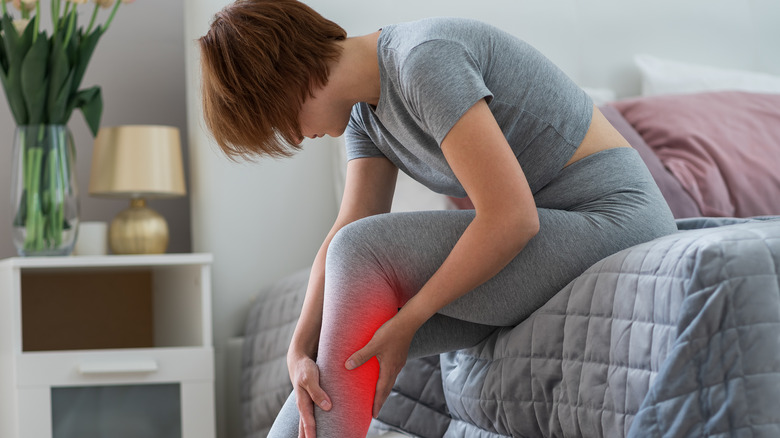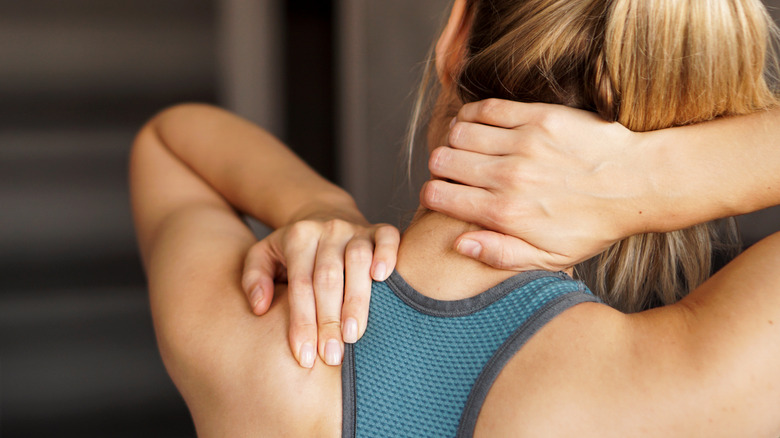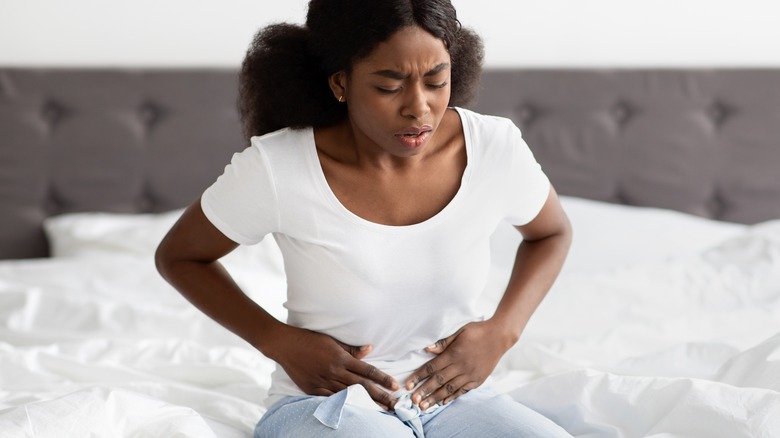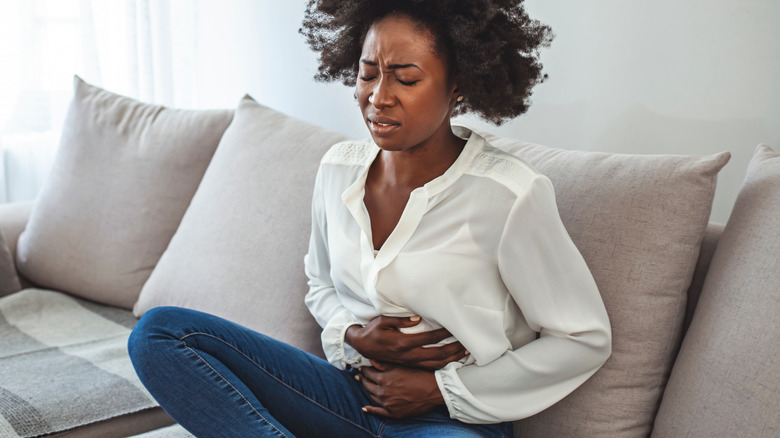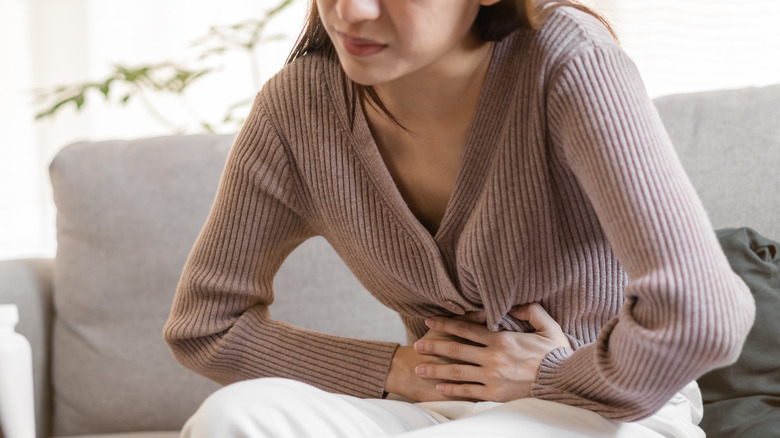What Does It Mean When When You Have Bad Cramps?
Sometimes, when you near the time of your monthly period, you may experience cramping before the period itself begins. Commonly known as premenstrual syndrome (PMS), this phenomenon can consist of various physical and emotional signs such as bloating and irritability in addition to cramping, and more than 90 percent of women experience it, per the Office on Women's Health. While some women are lucky to feel almost nothing before or during their periods, some have it so bad that they have to stay in bed, which feels like torture. You automatically turn to a pint of ice cream and cry, thinking about Noah and Allie's love story in "The Notebook."
Another common cramp you might have experienced is one during a workout. You're biking away or lifting some weights, and suddenly you get a cramp and have to stop. That is a muscle spasm that can happen anytime, and according to WebMD, a cramp is most commonly experienced on your legs but could happen anywhere on your body. Generally, a quick rest or some stretching can fix the situation. It's normal to experience cramps on random parts of your body due to movement or hormones, but some cramps are just too awful. Luckily, if you've ever wondered how to get rid of cramps, we've delved into the most common types of cramps so you don't have to.
The muscle cramp, aka charley horse
According to Medline Plus, muscle cramps, are "involuntary contractions or spasms in one or more of your muscles" and can happen for multiple reasons, such as muscle strain or dehydration. Muscle cramps can happen anytime and anywhere, but are most common when exercising. With proper warmups, stretching, a healthy diet, and plenty of fluids, you can try to prevent them. However, they aren't inherently dangerous most of the time. It is also possible to experience these cramps while sleeping.
The problem with muscle cramps — do you know the surprising reason they're called charley horses? — is when they happen too often, last too long, and are severely painful, which could have other underlying reasons such as being caused by a nerve disorder, per WebMD. Suppose you are also experiencing vomiting, numbness, diarrhea, weakness, or ample sweating, and it is just hurting a lot: In that case, see a doctor to get some blood work and tests done to make sure you are okay or catch it early to treat it properly. Otherwise, you don't have to worry about them, because almost everyone gets them.
The muscle strain
A little muscle spasm on the elliptical is normal, but it's possible to injure yourself if you work out really hard, leading to muscle strain. Now, this is more painful than a muscle cramp. The Mayo Clinic describes muscle strain as "an injury to a muscle or a tendon — the fibrous tissue that connects muscles to bones." If you do not work out correctly or do too much, you might put a lot of stress on the muscles or tendons, leading to "partial or complete tears in these tissues," harming just your muscles or both the muscles and the bones. Like a muscle cramp, you can treat a muscle strain by getting longer rest or a cold compress, but you might need surgery if the injury is severe. You'll be able to tell it is a strain because it will be more painful, and you might notice some swelling or bruising as well.
According to Healthline, muscle strains can affect your movement and could heal themselves in a couple of weeks or months, depending on how badly you've hurt yourself. Unfortunately, a muscle strain can happen any time, even when walking, and it is usually a result of skipping warmups or by over-exercising. A great way to reduce muscle strain is by adding strength training to your workout routine, because it'll make you stronger and less likely to experience such accidents.
The menstrual cramp
Many women dread their periods because they can be insanely painful, and there are several possible reasons behind that. According to Medline Plus, dysmenorrhea (commonly known as period pain or menstrual cramps) can be caused by the contraction of the uterus imitating giving birth due to the excess production of prostaglandins, a type of hormone the uterus makes.
Unfortunately, there is no set time on how long the pain lasts or when it starts because it depends on the individual. Some women experience such severe period pains that they have to skip work or school. You can probably blame your hormones or genetics for this one. Period cramps are temporary and go away on their own, but it may be best to consult a physician if the pain is too excruciating.
Everyday Health notes that you can treat menstrual cramps at home by adding yoga to your lifestyle. They shared the results of a study published in the Journal of Alternative and Complementary Medicine that showed that women who did regular yoga experienced fewer menstrual cramps than those who didn't. It looks like yoga truly can be good for the mind and the body. Otherwise, you can try home remedies like using a heating pad or employing over-the-counter medicine.
Cramps from endometriosis
No one enjoys menstrual cramps, and most of the time, they go away once you are done with a few dreadful days a month. However, if it is accompanied by excessive bleeding and severe cramps, worse than expected, it could be endometriosis, which starts when you are a bit older. Unfortunately, the pain associated with endometriosis is worse and tends to last longer than regular period pain, per Medline Plus.
The Mayo Clinic describes endometriosis as a painful health condition where "tissue similar to the tissue that normally lines the inside of your uterus — the endometrium — grows outside your uterus." It can also affect the other parts of your reproductive organs, like your ovaries. Sadly, researchers have not discovered what causes this, but people who have endometriosis also often struggle with infertility. If this is allowed to worsen, it could lead to cancer, per WebMD.
Health.com shared that about 10 percent of women experience endometriosis, and usually, it is discovered later in life. If your period pains are excruciating, it is best to get checked by a doctor because early diagnosis can help you in the long run. "Surgery can be a treatment, I think it's a treatment — but of last resort," Hugh Taylor, M.D., vice president of the American Society for Reproductive Medicine told Health.com.
Cramps from pelvic inflammatory disease
If your bad cramps aren't caused by a workout or period pain, there can be another reason: pelvic inflammatory disease (PID). According to the Centers for Disease Control and Prevention (CDC), PID is the infection of the female reproductive organs, and can result from untreated sexually transmitted diseases (STDs) or the use of an improperly placed intrauterine device (IUD).
The only way to avoid PID is to avoid all sexual activity. If you are sexually active, use protection or be smart about your choice of partners, making sure they also test negative for STDs. If you notice abnormal bleeding or severe cramping in the abdomen, it is best to get a diagnosis, as it is always better to treat a disease in its earlier stages because the cause could be PID.
WebMD shared that "PID is an infection of the organs of a women's reproductive system. They include the uterus, ovaries, fallopian tubes, and cervix." This affects about 770,000 women in the U.S. every year, and can ultimately also affect fertility. Consult a doctor if you are sexually active and experience severe pain in your tummy that seems more unusual than period cramps. It can be treated with antibiotics, but serious cases may require hospitalization.
Ultimately, no matter what is causing them, we've got you covered with the best ways to relieve stomach cramps.
